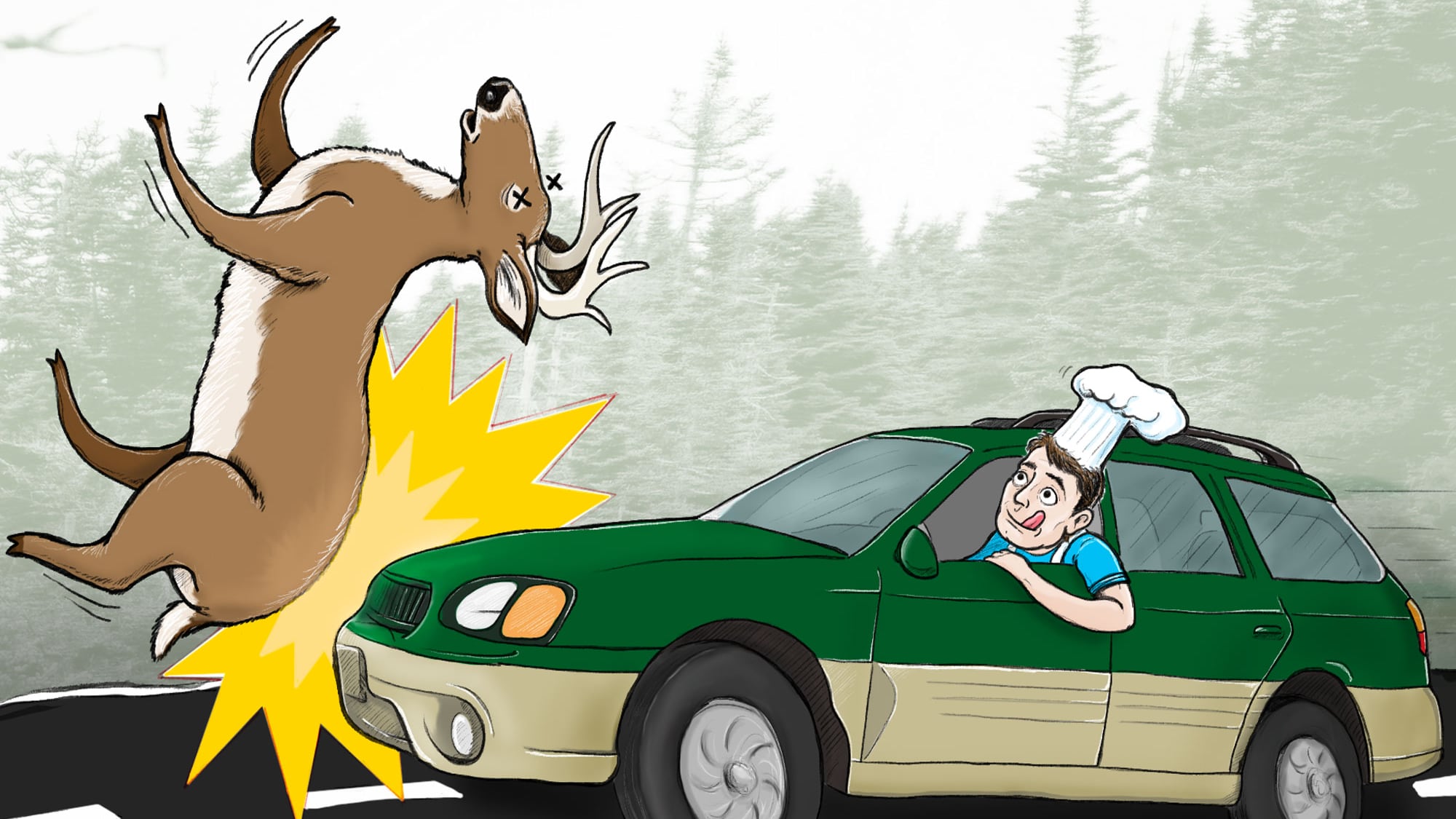The first time Peter Michael Bauer ate a dead animal from the side of the road, he was 16 years old.
He'd just returned to Portland after taking a survival skills course in New Jersey, and was on his way to work at a coffee shop when he spotted a recently deceased raccoon along Southwest Beaverton-Hillsdale Highway.
"It was a clean hit, so there wasn't any visible rupture of the organs or anything like that," Bauer says. "Basically, it had a crushed skull, which, in a sense, is one of the ideal scenarios."
That night, using the preparation techniques he'd learned back east, Bauer had raccoon thighs for dinner. It was delicious—like really fatty pork, he says.
Since then, Bauer, now the executive director of outdoor education nonprofit Rewild Portland, has eaten everything from venison tacos to beaver chili to stir-fried nutria.
Feel free to gag. But as of Jan. 1, roadkill is officially on the menu in Oregon.
Related: Less Than Two Months Remain Until You Can Legally Eat Prime Roadkill in Oregon.
State law now allows people to salvage the carcasses of large game animals, such as deer and elk, that have been accidentally struck by vehicles. (Smaller critters, like squirrels, porcupines and, yes, raccoons, have always been legal to take home.) Advocates, including People for the Ethical Treatment of Animals, argue the practice is more humane than leaving the animals to rot, and that roadkill provides more nutritional value than store-bought meat.
Of course, Oregonians can't just treat the highway like an open carniceria. Several rules have been put in place to prevent vehicular poaching. And then there's this important caveat: "Any person who salvages a deer or elk will consume the meat at their own risk."
For most urbanites, the notion of scraping your dinner off hot pavement probably seems like more trouble than it's worth, for a variety of reasons. But if you're looking to start eating like a really Old Portlander, we asked Bauer for a couple of quick tips. Note: Unless you're already sitting down to a bowl of beaver chili, you might want to put lunch on hold until after reading.
Say I spot an animal along the road that appears in good enough shape to eat. What's the first step?
If you come across a tasty-looking carcass on the side of the highway, your initial thought you should be, "How long has this thing been here?" Several telltale signs exist to age a piece of roadkill. How fresh is the blood? Is it coated in dust from passing cars? According to Bauer, one surefire way to scan for freshness is a literal eye test. "If the eyes are glassy and watery still, it's relatively fresh," he says. "Even if they're like bulging out of a skull, they'll still maintain a little bit of moisture for a while. As it ages, those eyes dry out and they look drier and cloudier and kind of crustier." After that, give the fur a yank. "If you pull on the fur and it stays in the skin, that's a good sign. That means the hide isn't rotten yet," he says. "If the fur pulls out of the animal, I won't eat it or even get the hide." Also make sure check the orifices for maggots—sure, it's gross, but hey, you're the one trying to eat roadkill.
So I've determined the animal is fresh enough to eat. Am I good to fry it up?
Of course, even if you blasted the creature off this mortal coil with your own Subaru, that doesn't automatically mean it's safe to eat—and Bauer says there's no way to be 100 percent sure the thing is disease-free. The good news is that cooking an animal well will kill most diseases. And there are ways to identify potential contamination. "When I'm gutting it, I'm looking at organs, specifically the liver," Bauer says. "If it has a spotted liver, if it's questionable at all, I probably won't eat the animal." A general rule of thumb is to avoid picking up roadkill in urban environments, where the animal is more likely to have consumed something poisonous or otherwise subsisted on garbage. According to Bauer, a 2006 study found 65 percent of city-dwelling raccoons in Portland carry Baylisascaris procyonis, or raccoon roundworm. "It's a parasite that has evolved to be inside of a raccoon, not a human," he says. "If it gets inside of a human, it doesn't know what to do. So it basically eats it's way through the body to the brain and then just eat holes in the brain." So, uh, y'know—as the law says, eat at your own risk.
This new law specifically pertains to deer and elk. What should I know about picking up bigger game?
As (mostly) herbivores, deer and elk are generally less likely to carry food-borne illnesses than smaller omnivores. (Depending on how long it's been dead, most of the things you'd have to worry about, such as ticks and fleas, will have moved on to a new, living host.) But taking home bigger game comes with another set of considerations—namely, time and storage. For instance, an elk could take days to properly process, and even longer to eat. Once it's chopped it up, you're not going to be able to fit it into anything smaller than a chest freezer. "You've got to be thinking several steps ahead," Bauer says. "I've done this thing before where I got a roadkill deer and called a bunch of friends. Everybody came over, we processed the animal, and everybody takes home a small amount. But, you know, for the most part nowadays, I would just try to process it into smaller chunks and then freeze the whole thing and keep it to myself."
Are there any general tips for cooking roadkill?
For Bauer, preparing roadkill for consumption is the same as a hunted animal. There is, however, one difference that can affect flavor. "Oftentimes when you catch an animal, you'll bleed it out really quick, to get that blood out of the animal so it doesn't coagulate," he says. "That's another one of those things that makes it taste a lot more gamier, that the blood coagulates in it. I definitely think that adds a factor in roadkill flavor, that they're just going to die there. Especially if their head got crushed or they have internal organ damage, they're going to bleed internally more so than they'd bleed externally." Bauer says soaking the animal in brine can help pull some of that blood and lessen the gaminess.
So what animals should I keep my eyes peeled for?
Bauer says raccoons remain the tastiest game he's tried. But if the whole aforementioned "brain-eating parasite" thing turns you off, nutria should be on the menu for carnivorous Oregonians, as the semi-aquatic South American rodents are considered an invasive species. Of course, most people are not going to be easily convinced of the palatability of what looks like a beaver-rat hybrid. The key, says Bauer, is preparation. "Best case scenario, it tastes like beef," he says. "It can be really tasty and you'd never even know what you're eating. But if you just roast it over a fire or something, or throw it on a barbecue without any preparation and cook it with the bone in, that's going to leach out all of that swampiness. Then by the time you get down to the bone, you're going to start tasting swamp."
Related: These 10 Species Could Destroy Oregon As We Now Know It.
What animals should I avoid?
This probably doesn't need to be said, but skunks are pretty rank. And Bauer isn't just guessing: A friend cooked one up as his first foray into roadkill cuisine. Bauer knew it was a bad idea—but he still had to try it. "You know like when you drink a glass of milk and your mouth is kind of coated with the milk fat?" he says. "The skunk was really oily. And so when I ate it, it coated my mouth with the skunk oil, which then also tasted like skunk. It just kind of lingered in my mouth."

